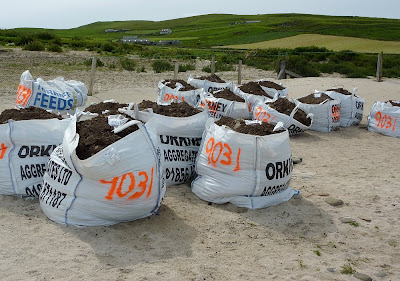Getting our group to a new island in a timely manner sometimes required ingenuity. Not that the formal ferries aren't doing a great job, it's just that our group needed maximum flexibility and minimum fuss and transit time. We were blessed with good weather for the next 2¾ days; here's a picture of our transport to Westray Island.
Leaving the harbor at Kirkwall, we glanced at the installation platform for tidal and wave energy experiments in Orkney. This creature can be towed to the equipment site, where it lowers the four legs.
Also in harbor was a large cruise ship. They stop regularly at Kirkwall to view the sights of the mainland, as we did in the previous post, and possibly to re-provision before heading to more distant shores, whether England, Ireland, Norway, or Iceland. It is much better to tour when you are not competing with the crowds bussed from these behemoths.
Looking back along our wake, the St. Magnus Cathedral and the energy installer dominate the skyline.
Leader David enjoys the rare Orcadian sunshine.
Wally bonded with the skipper of the boat, who gave him a turn at the helm.
At the Westray dock we were met by Graham Maben, co-founder of Westraak guided tours, along with his wife Kathy. They took us to their offices for a welcome snack and orientation before we set out. It would become obvious to us over the next two days how multi-talented Graham was, and how much of a booster for Westray. In bits and pieces we learned about the Westray Development Trust, which is a non-profit organization run by the islanders themselves to keep the island economically viable, and make it attractive for youth to stay rather than emigrate. Founded in 1998, by 2010 it has a number of successes under its belt.
Our first destination was the sea arch at Scaun. Here, Graham is explaining about some rare flora at this place.
This was the object of study, Scottish Primrose, Primula scotica.
The arch ...
Adult and juvenile cormorants were hanging out on the block to the right of the arch.
Then it was time to drive to the Links of Noltland, an expanse of dunes being stripped away by the wind. The neolithic settlements protected by the dunes are in danger of being destroyed soon by erosion, so Historic Scotland has funded rescue excavations. This is the site where the "Orkney Venus" statuette was uncovered in 2009. We'll see her in person tomorrow.
The setting of the dig.
The site leader was kind enough to give us a few minutes of explanation and answering questions. That we were with Graham didn't hurt, I'm sure. Sorry about catching her squinting into the sun!
As I mentioned, this is a rescue excavation at a rapidly eroding site. Therefore, much of what they dig is stored in numbered sacks for later, off-site sifting and processing. This lets them concentrate on the excavating.
The midden (prehistoric garbage/compost) contains lots of bones and shells. Food resources on Orkney may have been more plentiful 5,000 to 4,000 years ago.
Our next stop was at the Noup Head lighthouse and adjacent Noup Head RSPB (Royal Society for the Protection of Birds) reserve.
Lots of seabirds nest in the cliffs here -- guillemots, razorbills, fulmars, kittiwakes. And puffins.
It can get crowded.
The flat rocks at the foot of the lighthouse were crowded with seals.
Then it was time to check in and unpack at our hotel, Cleaton House, and soon after there was entertainment before dinner. A band composed of local youth played Orcadian tunes for us. They called themselves the "Young Band."
They were very good, but the performance had an eerie overtone because the band members outnumbered the audience (us). It turns out that the new hotel owners (the previous owners now run the Lynnfield on mainland, where we had just been!) discourage locals from dropping in for a pint or a dram, to focus on the overnight guests. It reduces the workload but it also reduces the business.
After dinner -- sunset was not until 10:30 or so -- Graham took us puffin-watching; July is near the end of the puffin viewing season, before they migrate out to sea again. We hiked along a footpath to a rock stack, Castle o'Burrian, that was the site of an early Christian hermitage. This is the view as we approached the stack.
As we watched, puffins continued to land on the stack, delivering food to their burrows and generally settling in for the short night.
The crowd grew thicker as the sun grew lower.
Graham led us around to see the other side of the stack.
It was twilight by the time we returned to the bus. A short snooze at the hotel would be followed by another day of excellent weather and adventure.

























No comments:
Post a Comment
Comments may not appear immediately as they are moderated by the author to eliminate spam.